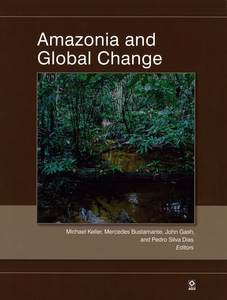Ecophysiology of forest and savanna vegetation
Lloyd, J., Goulden, M.L., Ometto, J.P., Patiño, S., Fyllas, N.M., and Quesada, C.A. (2009) Ecophysiology of forest and savanna vegetation. In: Keller, Michael, Bustamante, Mercedes, Gash, John, and Silva Dias, Pedro, (eds.) Amazonia and Global Change. Geophysical Monograph Series, 186 . American Geophysical Union, Washington, DC, USA, pp. 463-484.
![[img]](https://researchonline.jcu.edu.au/18027/3.hassmallThumbnailVersion/18027_Lloyd_et_al_2009_cover.jpg)
|
Image (JPEG) (Book Cover)
- Cover Image
Download (539kB) |
|
|
PDF (Published Version)
- Published Version
Restricted to Repository staff only |
Abstract
Ecophysiological characteristics of forest and savanna vegetation are compared in an attempt to understand how physiological differences within and between these vegetation types relate to their geographical distributions. A simple ordination first shows that although precipitation exerts a key effect on Amazonian vegetation distributions, soil characteristics are also important. In particular, it is found that under similar precipitation regimes, deciduous forests tend to occur on more fertile soils than do cerrado vegetation types. A high subsoil clay content is also important in allowing the existence of semievergreen forests at only moderate rainfall. Such observations are consistent with biome specific physiological characteristics. For example, deciduous trees have higher nutrient requirements than do evergreen ones which also tend to have characteristics associated with severe water deficits such as a low specific leaf area. Nutrient contents and photosynthetic rates are lower than for savanna than for forest species with several ecosystem characteristics suggesting a primary limitation of nitrogen on savanna productivity. By contrast, phosphorus seems to constrain the productivity of most Amazonian forest types. Differentiation is made between the fast-growing, high-nutrient-requiring forest types of western Amazonia and their counterparts in eastern Amazonia, which tend to occupy infertile but deeper soils of high water-holding ability. On the basis of observed physiological characteristics of the various vegetation forms, it is argued that, should Amazonian precipitation decline sharply in the future, the slower growing forests of eastern Amazonia will transform directly into an evergreen cerrado type vegetation but with the more fertile western Amazonian forests being replaced by some form of drought-deciduous vegetation.
| Item ID: | 18027 |
|---|---|
| Item Type: | Book Chapter (Research - B1) |
| ISBN: | 978-0-87590-476-4 |
| ISSN: | 0065-8448 |
| Date Deposited: | 08 May 2012 04:17 |
| FoR Codes: | 06 BIOLOGICAL SCIENCES > 0607 Plant Biology > 060705 Plant Physiology @ 50% 06 BIOLOGICAL SCIENCES > 0602 Ecology > 060208 Terrestrial Ecology @ 50% |
| SEO Codes: | 96 ENVIRONMENT > 9699 Other Environment > 969999 Environment not elsewhere classified @ 100% |
| Downloads: |
Total: 783 Last 12 Months: 19 |
| More Statistics |



